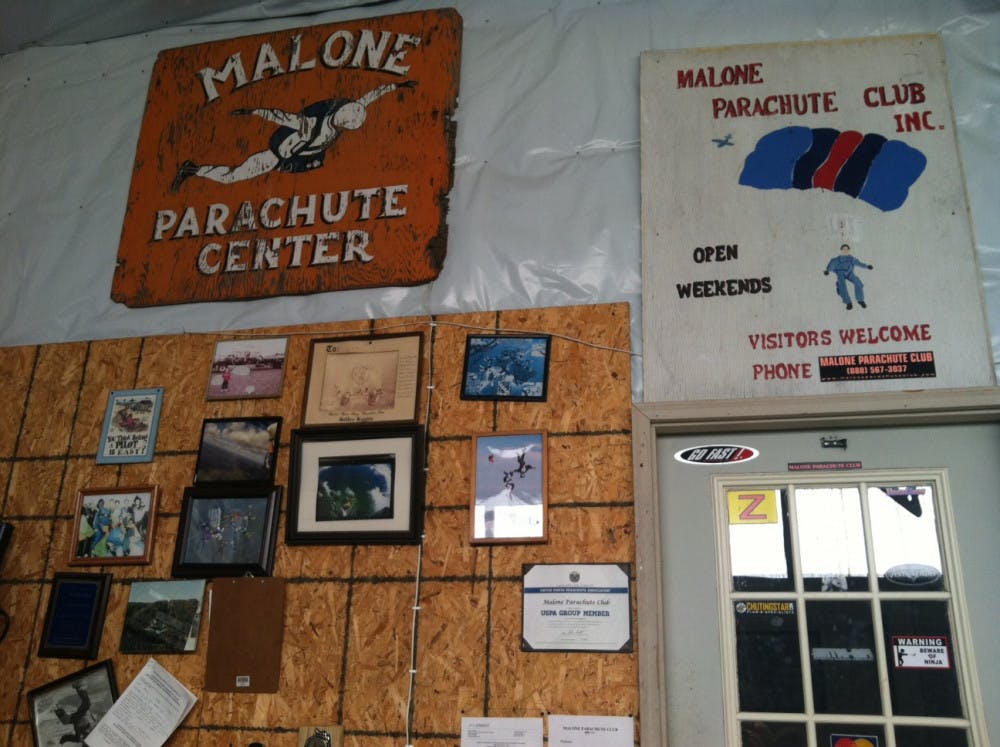From 10,000 feet in the air, the Malone Parachute Club is just a small white box, indistinguishable from the neighboring hangars lining the airport. That is the altitude to which first time jumpers ascend for skydiving, and the height that Dave Malone took a local editor last Sunday for a tandem jump.
Dave is the son of Dick Malone, the pilot of the plane and one of the older members of the not-for-profit club. The club itself has been around for over 40 years, when a group of skydivers first purchased the assets from a New York company. Both father and son have been jumping for decades.
Last Sunday, the inside of their hangar was loud with the chatter of their friends, experienced jumpers coming in early to sign up on the daily schedule.
The weather looked foreboding, but most were confident that the sky would clear up for a few “hop and pops” – quick ascents to altitudes below 10,000 feet.
As the flurries of snow died down, they would begin to playfully tease the slower packers. One younger jumper, slower to pack his bag, joked that he’d slap the target with his hand when he landed.
Eventually, the crew left the heated hangar and squeezed into a small red and white airplane. Minutes later, they jumped, plummeted to earth for several seconds, and then glided down gracefully ‘under canopy’ after deploying their parachutes.
For first time jumpers, the club is reassuring, professional and friendly. Dave walks a newbie through the safety procedures slowly and deliberately.
He starts by explaining that the forms you are required to sign, waivers ensuring you understand the risk involved, are there for a reason.
He explained that skydiving involves a certain amount of risk, and that something could go wrong. But he also emphasized that there is risk in lots of sports, and that he is taking the same risk.
“We are in this together,” he said confidently.
Next, Dave went through the equipment piece by piece, explaining what the various harnesses did, how the altimeter works, what hand signals to pay attention to and how the jump would feel. He explained how the jumpsuits worked and how to put on the helmet, which looked like a football helmet out of the early 1950’s.
Tandem jumpers are attached to an instructor at four points, two at the hips, and two at the shoulders. Each joint is designed to hold the weight of the student should the others fail.
There are several backup parachute systems, and one even designed to deploy should both jumpers somehow become unconcious. For first time jumpers, this is reassuring.
Next he reviewed the different positions that the student will assume after exiting the airplane. The student starts in a cannonball pose, acting as the weight of the duo, and later assumes the same spread position as the instructor.
“Think of it like a badminton birdie,” he explained. “I’m the feathers, and you’re the ball.”
After clambering aboard the plane and ascending for several minutes, Dave began to review the procedure for exiting the plane. The door swings open, and the tandem pair climbs out together underneath the inner part of the wing.
For a few brief seconds, the view from 10,000 feet above the ground is spectacular. The club is located just minutes from the Canadian border, overlooking Lake Champlain in Swanton, Vermont.
Then, both jumpers tuck and roll backward, falling back off the wing and flipping as they shoot earthward.
At around 6,000 feet, Malone deployed the parachute and steered the two riders safely to the ground. Upon exiting the plane to touching the ground, the entire jump takes around just sixty seconds.
Although first timers are required to do tandem jumps, the club also offers static line jumps to those who are interested. These are solo jumps, but the parachute will trigger automatically at a certain height.
Most of the jumpers present on Sunday were veterans, and had racked up jump counts into the high thousands. They were thrilled to be sharing the experience with a new jumper, and were contratulatory when the duo arrived back to the runway.
Back at the hangar, the veterans traded jokes about their equipment in a language too difficult for a newcomer to parse. In fact, the most impressionable part of Malone Skydiving Club was was the feeling of fraternity among the skydivers. As the day wore on, they filmed the jumps on GoPro cameras, and took the footage into the back office to watch. They ribbed one jumper about his poor landing, and in another video, about the skydiver’s profanity while gliding down through a small flurry of snow.
Unfortunately for the skydiving community there, the cold weather means an end to the season. Malone Skydiving Club will reopen in April.
In the meantime, the group made contingency plans. Among them: a group jump in Mexico.
Malone Skydiving Club Thrills New Jumpers

Comments


